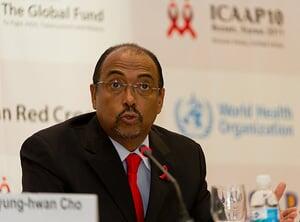BUSAN, Republic of Korea (UNAIDS news release) – The AIDS epidemic in Asia and the Pacific is at a crossroads, according to a new report from the Joint United Nations Programme on HIV/AIDS (UNAIDS). While the region has seen impressive gains – including a 20% drop in new HIV infections since 2001 and a three-fold increase in access to antiretroviral therapy since 2006 – progress is threatened by an inadequate focus on key populations at higher risk of HIV infection and insufficient funding from both domestic and international sources.
Launched at the 2011 International Congress on AIDS in Asia and the Pacific (ICAAP), the report, titled HIV in Asia and the Pacific: Getting to Zero , found that more people than ever before have access to HIV services across the region. However, most countries in the region are a long way from achieving universal access goals for HIV prevention, treatment, care and support.
“Getting to zero new HIV infections in Asia and the Pacific will demand national responses based on science and the best available evidence,” said UNAIDS Executive Director Michel Sidibe. “HIV programmes must be sufficiently resourced and solidly focused on key populations. Investments made today will pay off many-fold in the future.”
Gains in the regional HIV response, but progress is fragile
According to the report, an estimated 4.9 million [4.5 million-5.5 million] people were living with HIV in Asia and the Pacific in 2009, a figure that has remained relatively stable since 2005. The majority of people living with HIV in the region are in 11 countries: Cambodia, China, India, Indonesia, Malaysia, Myanmar, Nepal, Pakistan, Papua New Guinea, Thailand and Viet Nam.
Across Asia and the Pacific, there was a 20% decline in new HIV infections between 2001 and 2009 – from 450, 000 [410, 000-510, 000] to 360, 000 [300, 000-440, 000]. Cambodia, India, Myanmar and Thailand have reduced their HIV infection rates significantly with intensive, wide reaching HIV prevention programmes for people who buy and sell sex.
The number of people accessing life-saving antiretroviral treatment in the region has tripled since 2006, reaching some 740 000 people at the end of 2009. Cambodia is one of only eight countries in the world to provide antiretroviral therapy to more than 80% of the people eligible for it. However, as of end-2009, more than 60% of people in Asia and the Pacific who were eligible for treatment still could not access it.
The report found an estimated 15% decrease in new HIV infections among children since 2006. But regional coverage of HIV services to prevent new HIV infections in children continues to lag behind global averages, particularly in South Asia.
According to the report, HIV epidemics can emerge even in countries where HIV prevalence was previously low. After a more than 20-year ‘low and slow’ HIV epidemic in the Philippines, for example, the country now has a rapidly expanding epidemic among key populations. In the city of Cebu, HIV prevalence among people who inject drugs increased from 0.6% to 53% between 2009 and 2011. In Manila and Cebu, HIV prevalence among men who have sex with men is estimated at 5%.
Key populations at higher risk of HIV infection
According to the report, new HIV infections in the region remain concentrated among key populations: people who buy and sell sex, people who inject drugs, men who have sex with men, and transgender people. Most programmes to protect key populations and their intimate partners from HIV infection are inadequate in size and scale.
Across the region, stigma and discrimination against people living with HIV and populations at higher risk of infection remain rife. About 90% of the countries in the region retain punitive laws and policies that effectively prevent people living with HIV and key populations from accessing life-saving HIV services.
Data suggest that a significant proportion of new HIV infections within key populations are among young people under the age of 25. In most settings, HIV prevention programmes are failing to sufficiently reach young people most at risk.
More AIDS resources urgently needed
The AIDS response in Asia and the Pacific is underfunded, the report found. In 2009, an estimated US$ 1.1 billion was spent on the AIDS response in 30 countries across the region – approximately one third of the funding needed to achieve universal access goals to HIV services.
Though China, Malaysia, Pakistan, Samoa and Thailand are funding the bulk of their HIV response from domestic resources, many countries in Asia and the Pacific depend heavily on foreign funding, particularly for the provision of antiretroviral therapy. Increased investment of domestic resources, especially in middle-income countries, is critical for the ongoing regional response to HIV.
Funding cutbacks from international donors also threaten progress in the regional AIDS response. In 2009, international assistance for the global AIDS response leveled off for the first time in a decade, and in 2010 it declined.
According to the report, investments to protect key populations from HIV remain insufficient. Among countries reporting detailed expenditure data in 2010, only 8% of total AIDS spending in South Asia and 20% in Southeast Asia focused on HIV prevention among key populations at higher risk of HIV infection.
For more information, please contact:
Beth Magne Watts, tel. +66 81 835 3476 or +82 105 677 2334, magnewattsb@unaids.org
Saira Stewart, tel. +41 79 467 2013, stewarts@unaids.org


